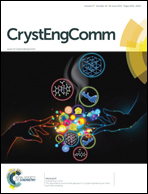Features of styryl dye crystal packings and their influence on [2 + 2] photocycloaddition reaction with single crystal retention†
Abstract
A new styryl dye of the 2-benzothiazole series which contains three methoxy groups and an iodide anion was synthesized. Three triclinic crystal forms of this dye were investigated by single crystal X-ray diffraction. All the modifications were shown to contain centrosymmetrically related stacks of cations with the syn-“head-to-tail” mutual arrangement. Stacks of cations are arranged as dimeric pairs with short interatomic distances between the ethylene group carbon atoms, d1 = 3.54–3.75 Å and significantly longer analogous distances between the adjacent pairs, d2 = 4.61–4.68 Å. The main difference of the packing consists in various orientations of N-ethyl substituents with respect to the centre of the dimer. The solid phase [2 + 2] photocycloaddition (PCA) reaction resulting in rctt isomer of the cyclobutane derivative, only proceeds in pairs where N-substituents are oriented outward from the centre of the dimeric pair. PCA is accomplished as a “single crystal-to-single crystal” transformation.
![Graphical abstract: Features of styryl dye crystal packings and their influence on [2 + 2] photocycloaddition reaction with single crystal retention](/en/Image/Get?imageInfo.ImageType=GA&imageInfo.ImageIdentifier.ManuscriptID=C5CE00653H&imageInfo.ImageIdentifier.Year=2015)

 Please wait while we load your content...
Please wait while we load your content...